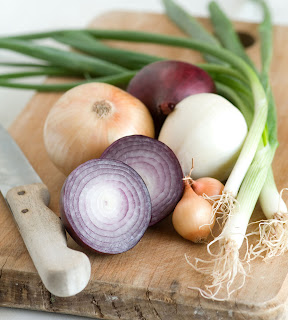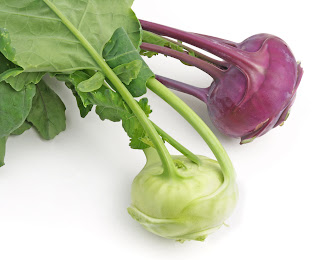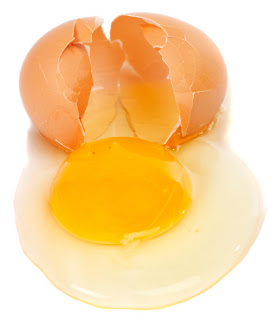Answer: Busted!
One half cup of onions provides a good source of vitamin C, potassium, calcium, magnesium, phosphorus and dietary fiber. Onions are fat free and low in calories, yet add abundant flavor to a wide variety of foods.
Additional nutrition information can be found at http://missourifamilies.org.
Contributor: Maude Harris, Nutrition and Health Education Specialist, University of Missouri Extension, harrismau@missouri.edu, 573.545.3516
Friday, July 29, 2011
Myth: Onions have no nutritional value.
Labels:
Fruits/Veggies
Wednesday, July 27, 2011
Myth: Turnips and kohlrabi are the same thing.
Answer: Busted!
Kohlrabi belongs to the cabbage family and got its name from a German word meaning "cabbage-turnip." Both the leaves and swollen underground stem are edible, especially the stem which can be green, white or purple.
Although similar in taste to a turnip, its flavor is milder. It can be steamed, battered and deep fried, or eaten raw, added to salads and stir fry.
The MissouriFamilies website has a Kohlrabi and Cabbage Slaw recipe and the MU Extension Healthy Lifestyle Initiative offers an instructional video on sautéing kohlrabi.
Contributor: Maude Harris, Nutrition and Health Education Specialist, University of Missouri Extension, harrismau@missouri.edu, 573.545.3516
Kohlrabi belongs to the cabbage family and got its name from a German word meaning "cabbage-turnip." Both the leaves and swollen underground stem are edible, especially the stem which can be green, white or purple.
Although similar in taste to a turnip, its flavor is milder. It can be steamed, battered and deep fried, or eaten raw, added to salads and stir fry.
The MissouriFamilies website has a Kohlrabi and Cabbage Slaw recipe and the MU Extension Healthy Lifestyle Initiative offers an instructional video on sautéing kohlrabi.
Contributor: Maude Harris, Nutrition and Health Education Specialist, University of Missouri Extension, harrismau@missouri.edu, 573.545.3516
Labels:
Fruits/Veggies
Friday, July 22, 2011
Myth: If the peeling on Ugli fruit is green, that means it is not ripe.
Answer: Busted!
The Ugli fruit's appearance may live up to its name but don't let that put you off. It can be green or yellow with a mottled skin and is called ugli fruit because it is ugly. It comes in odd shapes and pot-marked skin, ranging in size from that of a baseball to a giant grapefruit.
The ugli fruit's skin is very thick and when peeled, contains acid-sweet, yellow-orange pulp segments that are free of seeds. Pick the ones which feel heavy and give a little when pressed. It is eaten like an orange and is packed with vitamin C. It can be refrigerated for up to 3 weeks, or stored at room temperature for up to 5 days.
Additional nutrition information can be found at http://missourifamilies.org.
Contributor: Maude Harris, Nutrition and Health Education Specialist, University of Missouri Extension, harrismau@missouri.edu, 573.545.3516
The Ugli fruit's appearance may live up to its name but don't let that put you off. It can be green or yellow with a mottled skin and is called ugli fruit because it is ugly. It comes in odd shapes and pot-marked skin, ranging in size from that of a baseball to a giant grapefruit.
The ugli fruit's skin is very thick and when peeled, contains acid-sweet, yellow-orange pulp segments that are free of seeds. Pick the ones which feel heavy and give a little when pressed. It is eaten like an orange and is packed with vitamin C. It can be refrigerated for up to 3 weeks, or stored at room temperature for up to 5 days.
Additional nutrition information can be found at http://missourifamilies.org.
Contributor: Maude Harris, Nutrition and Health Education Specialist, University of Missouri Extension, harrismau@missouri.edu, 573.545.3516
Labels:
Fruits/Veggies
Tuesday, July 19, 2011
Myth: Squash blossoms cannot be eaten.
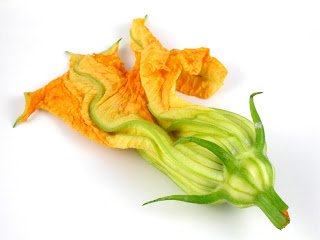 Answer: Busted!
Answer: Busted!Squash have edible blossoms that you can eat raw or cooked. Both summer and winter squash blossoms are edible.
It is recommended that you pick male blossoms because female blossoms are the fruit producers, unless you want to reduce production. Male blossoms are easily distinguished from the female blossoms. The stem of the male blossom is thin and trim. The stem of the female blossom is very thick. At the base of the female flower, below the petals, is a small bulge where the squash is developing.
Gently rinse the blossoms in a pan of cool water and store in ice water in the refrigerator until ready to use. The flowers can be stored for a few hours or up to 1 or 2 days. The blossoms can be battered and fried in a little oil for a wonderful taste sensation. Another way to prepare them is to sautée the blossoms in olive oil and garlic for a few minutes, then serve.
Additional nutrition information can be found at: http://missourifamilies.org.
Contributor: Maude Harris, Nutrition and Health Education Specialist, University of Missouri Extension, harrismau@missouri.edu, 573.545.3516
Labels:
Fruits/Veggies
Wednesday, July 13, 2011
Myth: Plantains and bananas are the same thing.
Answer: Busted!
Many people confuse plantains with bananas. Although they look a lot like green bananas and are a close relative, plantains are very different. Plantains are starchy, not sweet, and they are used as a vegetable in many recipes, especially in Latin America and Africa. Plantains are sold in the fresh produce section of the supermarket. They usually resemble green bananas, but ripe plantains may be black in color. Plantains are longer than bananas and they have thicker skins. They also have natural brown spots and rough areas.
Additional nutrition information can be found at http://missourifamilies.org.
Contributor: Maude Harris, Nutrition and Health Education Specialist, University of Missouri Extension, harrismau@missouri.edu, 573.545.3516
Many people confuse plantains with bananas. Although they look a lot like green bananas and are a close relative, plantains are very different. Plantains are starchy, not sweet, and they are used as a vegetable in many recipes, especially in Latin America and Africa. Plantains are sold in the fresh produce section of the supermarket. They usually resemble green bananas, but ripe plantains may be black in color. Plantains are longer than bananas and they have thicker skins. They also have natural brown spots and rough areas.
Additional nutrition information can be found at http://missourifamilies.org.
Contributor: Maude Harris, Nutrition and Health Education Specialist, University of Missouri Extension, harrismau@missouri.edu, 573.545.3516
Labels:
Fruits/Veggies
Monday, July 11, 2011
Myth: I can use raw eggs to make homemade ice cream and it won't make me sick.
Answer: Busted!
Raw eggs, if not pasteurized, can be dangerous. They can be a source of a foodborne illness caused by Salmonella enteritidis bacteria. Therefore, it is advised that you start with a cooked egg base for ice cream. This is especially important if you’re serving people at high risk for foodborne infections: infants, older adults, pregnant women and those with weakened immune systems.
You can still enjoy homemade ice cream without the risk of Salmonella infection by substituting a pasteurized egg product or egg substitute, or finding a recipe without eggs.
Another option for safe homemade ice cream is to use a cooked egg base. The American Egg Board has a recipe for homemade ice cream made with eggs that are heated to an internal temperature of 160 degrees Fahrenheit and then cooled. This temperature will kill Salmonella, if present.
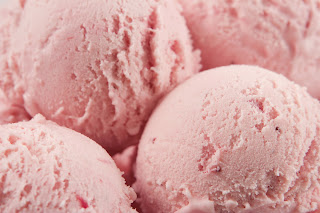 By following safe food handling and cooking practices, you can enjoy refreshing, tasty homemade ice cream without worrying about making anyone sick!
By following safe food handling and cooking practices, you can enjoy refreshing, tasty homemade ice cream without worrying about making anyone sick!
Additional nutrition, health and food safety information can be found at http://missourifamilies.org/.
Contributor: Maude Harris, Nutrition and Health Education Specialist, University of Missouri Extension, harrismau@missouri.edu, 573.545.3516
Raw eggs, if not pasteurized, can be dangerous. They can be a source of a foodborne illness caused by Salmonella enteritidis bacteria. Therefore, it is advised that you start with a cooked egg base for ice cream. This is especially important if you’re serving people at high risk for foodborne infections: infants, older adults, pregnant women and those with weakened immune systems.
You can still enjoy homemade ice cream without the risk of Salmonella infection by substituting a pasteurized egg product or egg substitute, or finding a recipe without eggs.
Another option for safe homemade ice cream is to use a cooked egg base. The American Egg Board has a recipe for homemade ice cream made with eggs that are heated to an internal temperature of 160 degrees Fahrenheit and then cooled. This temperature will kill Salmonella, if present.
 By following safe food handling and cooking practices, you can enjoy refreshing, tasty homemade ice cream without worrying about making anyone sick!
By following safe food handling and cooking practices, you can enjoy refreshing, tasty homemade ice cream without worrying about making anyone sick!Additional nutrition, health and food safety information can be found at http://missourifamilies.org/.
Contributor: Maude Harris, Nutrition and Health Education Specialist, University of Missouri Extension, harrismau@missouri.edu, 573.545.3516
Labels:
Food safety,
Foodborne illness
Friday, July 8, 2011
Myth: Throw away eggs with blood spots in the yolk.
Answer: Busted!
Occasionally, a small blood spot will appear in an egg yolk. This actually indicates an extremely fresh egg. This does not indicate a fertile egg, but rather a ruptured capillary on the yolk surface during the egg formation. These eggs are safe to eat and the blood spot can be removed with a knife for better appearance.
Additional nutrition and health information can be found at http://missourifamilies.org.
Contributor: Maude Harris, Nutrition and Health Education Specialist, University of Missouri Extension, harrismau@missouri.edu, 573.545.3516
Occasionally, a small blood spot will appear in an egg yolk. This actually indicates an extremely fresh egg. This does not indicate a fertile egg, but rather a ruptured capillary on the yolk surface during the egg formation. These eggs are safe to eat and the blood spot can be removed with a knife for better appearance.
Additional nutrition and health information can be found at http://missourifamilies.org.
Contributor: Maude Harris, Nutrition and Health Education Specialist, University of Missouri Extension, harrismau@missouri.edu, 573.545.3516
Labels:
Eggs
Wednesday, July 6, 2011
Myth: A serving of ackee has the same amount of calories as a large egg.
 Answer: Busted!
Answer: Busted!One serving of ackee is 25 calories, while a large egg has about 78 calories. Ackee has high nutritional value and is rich in essential fatty acids, vitamin A, zinc and protein.
Ackee is a Jamaican fruit that is creamy yellow in color and has a texture very much like scrambled eggs when cooked. The fruit of the ackee is not edible in its entirety. Only the inner, fleshy yellow arils are consumed. It is usually served with salted cod fish.
Ackee must be harvested, prepared and cooked properly. The pods should be allowed to ripen and open naturally on the tree before picking. Then you can easily extract the fleshy yellow bits. These edible yellow bits, called the arils, must be boiled for 30 minutes and then drain the water. Keep in mind that raw ackee and the inner red tissue of the ripe ackee arils contain toxins which can produce a syndrome of vomiting, seizures and sometimes fatal hypoglycemia (low blood sugar).
For information on other health and nutrition topics, visit the MissouriFamilies website.
Contributor: Maude Harris, Nutrition and Health Education Specialist, University of Missouri Extension, harrismau@missouri.edu, 573.545.3516
Labels:
Fruits/Veggies
Subscribe to:
Posts (Atom)

